Spinal Cord Injury: Impact, Symptoms, Treatment, and Management Plan
VerifiedAdded on 2023/06/09
|5
|1128
|252
Report
AI Summary
This report offers a comprehensive overview of spinal cord injury (SCI), detailing its impact on the body and potential effects. It explores the causes of SCI, including trauma, compression, and other factors leading to either complete or incomplete injuries affecting the spinal cord's function. The report then outlines the signs and symptoms, which vary depending on the injury's location and severity. Furthermore, it discusses treatment and management strategies, starting with initial interventions like breathing support and immobilization, followed by the use of steroids and potential surgical interventions to relieve pressure and stabilize the spine. The report emphasizes rehabilitation techniques such as occupational and physical therapy. The report concludes by highlighting the importance of understanding the condition and its management.
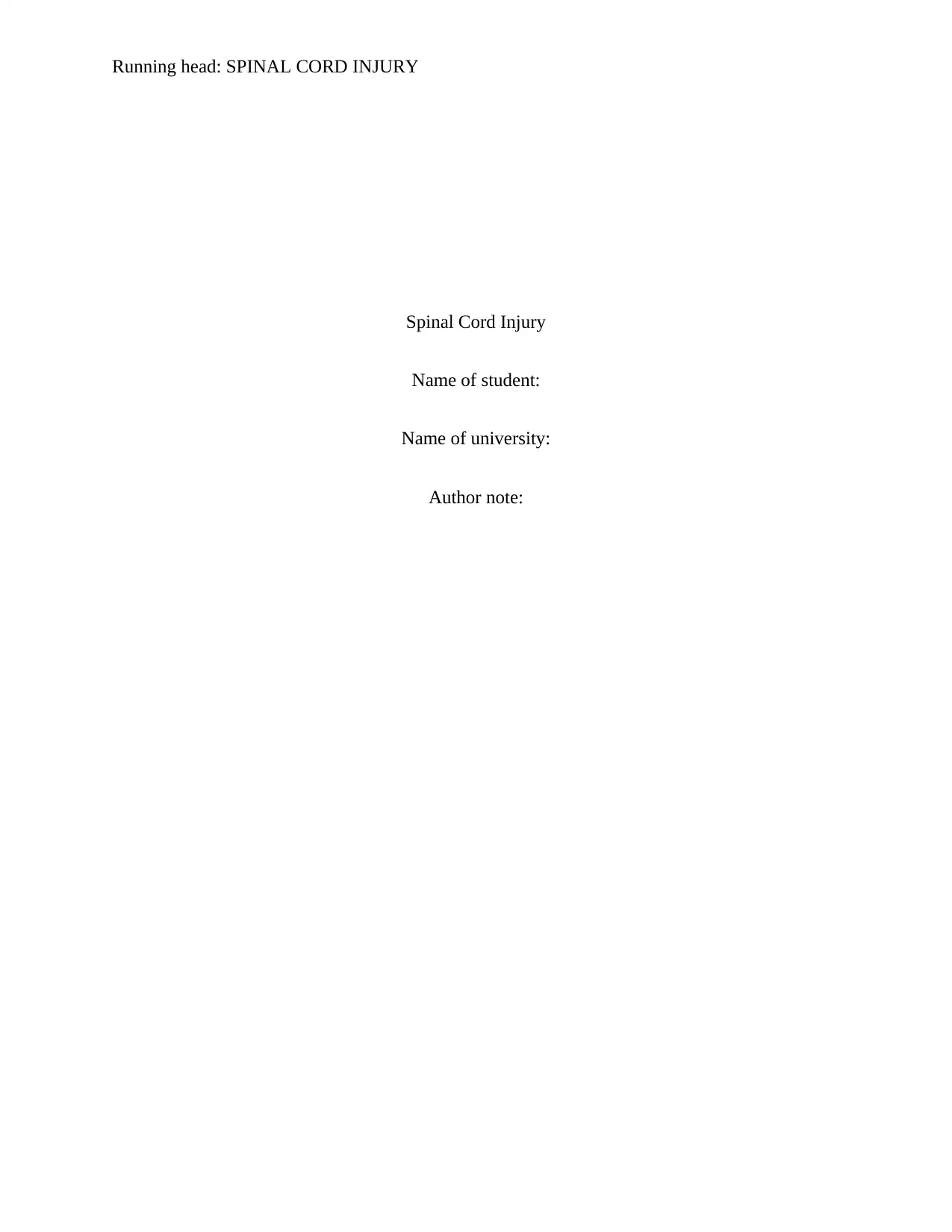
Running head: SPINAL CORD INJURY
Spinal Cord Injury
Name of student:
Name of university:
Author note:
Spinal Cord Injury
Name of student:
Name of university:
Author note:
Paraphrase This Document
Need a fresh take? Get an instant paraphrase of this document with our AI Paraphraser
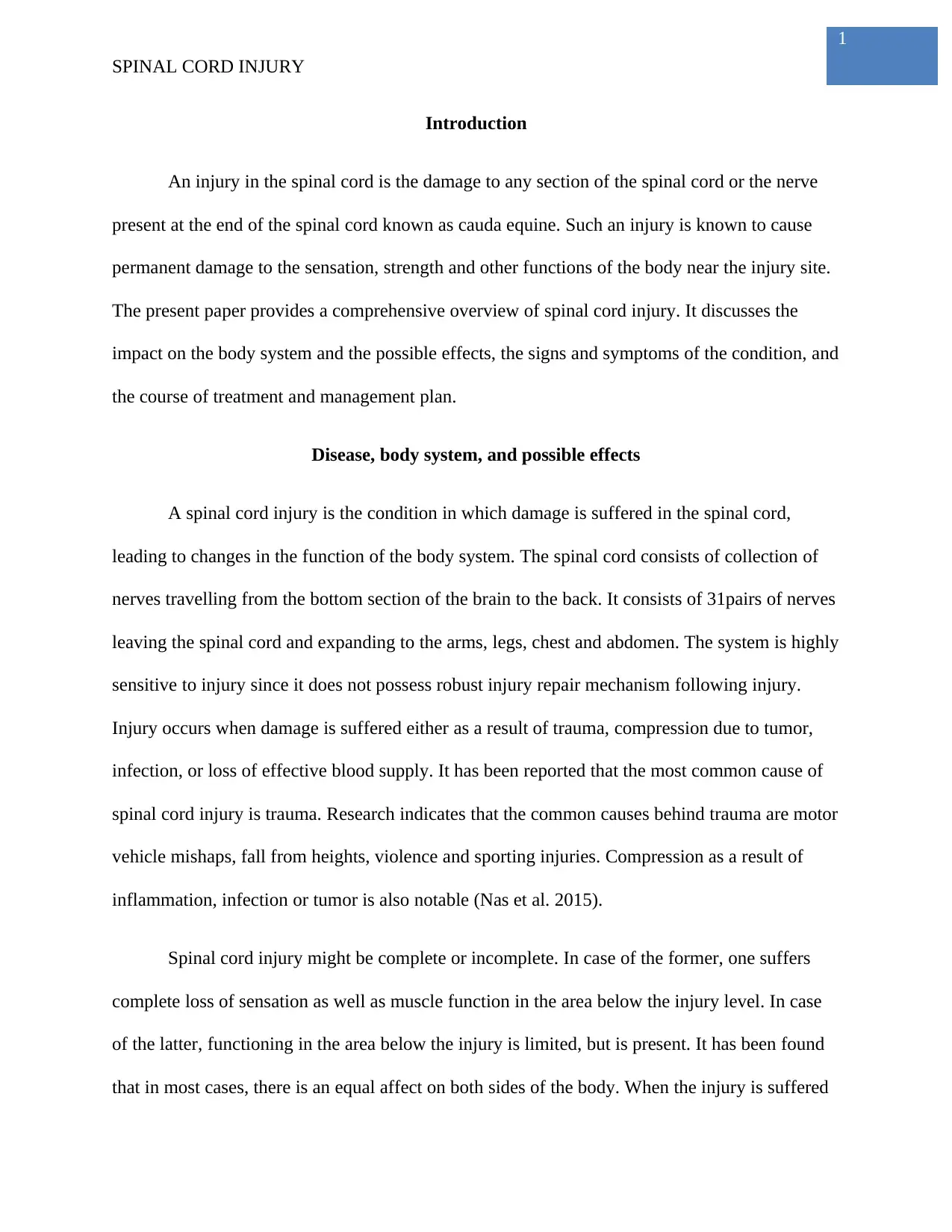
1
SPINAL CORD INJURY
Introduction
An injury in the spinal cord is the damage to any section of the spinal cord or the nerve
present at the end of the spinal cord known as cauda equine. Such an injury is known to cause
permanent damage to the sensation, strength and other functions of the body near the injury site.
The present paper provides a comprehensive overview of spinal cord injury. It discusses the
impact on the body system and the possible effects, the signs and symptoms of the condition, and
the course of treatment and management plan.
Disease, body system, and possible effects
A spinal cord injury is the condition in which damage is suffered in the spinal cord,
leading to changes in the function of the body system. The spinal cord consists of collection of
nerves travelling from the bottom section of the brain to the back. It consists of 31pairs of nerves
leaving the spinal cord and expanding to the arms, legs, chest and abdomen. The system is highly
sensitive to injury since it does not possess robust injury repair mechanism following injury.
Injury occurs when damage is suffered either as a result of trauma, compression due to tumor,
infection, or loss of effective blood supply. It has been reported that the most common cause of
spinal cord injury is trauma. Research indicates that the common causes behind trauma are motor
vehicle mishaps, fall from heights, violence and sporting injuries. Compression as a result of
inflammation, infection or tumor is also notable (Nas et al. 2015).
Spinal cord injury might be complete or incomplete. In case of the former, one suffers
complete loss of sensation as well as muscle function in the area below the injury level. In case
of the latter, functioning in the area below the injury is limited, but is present. It has been found
that in most cases, there is an equal affect on both sides of the body. When the injury is suffered
SPINAL CORD INJURY
Introduction
An injury in the spinal cord is the damage to any section of the spinal cord or the nerve
present at the end of the spinal cord known as cauda equine. Such an injury is known to cause
permanent damage to the sensation, strength and other functions of the body near the injury site.
The present paper provides a comprehensive overview of spinal cord injury. It discusses the
impact on the body system and the possible effects, the signs and symptoms of the condition, and
the course of treatment and management plan.
Disease, body system, and possible effects
A spinal cord injury is the condition in which damage is suffered in the spinal cord,
leading to changes in the function of the body system. The spinal cord consists of collection of
nerves travelling from the bottom section of the brain to the back. It consists of 31pairs of nerves
leaving the spinal cord and expanding to the arms, legs, chest and abdomen. The system is highly
sensitive to injury since it does not possess robust injury repair mechanism following injury.
Injury occurs when damage is suffered either as a result of trauma, compression due to tumor,
infection, or loss of effective blood supply. It has been reported that the most common cause of
spinal cord injury is trauma. Research indicates that the common causes behind trauma are motor
vehicle mishaps, fall from heights, violence and sporting injuries. Compression as a result of
inflammation, infection or tumor is also notable (Nas et al. 2015).
Spinal cord injury might be complete or incomplete. In case of the former, one suffers
complete loss of sensation as well as muscle function in the area below the injury level. In case
of the latter, functioning in the area below the injury is limited, but is present. It has been found
that in most cases, there is an equal affect on both sides of the body. When the injury is suffered
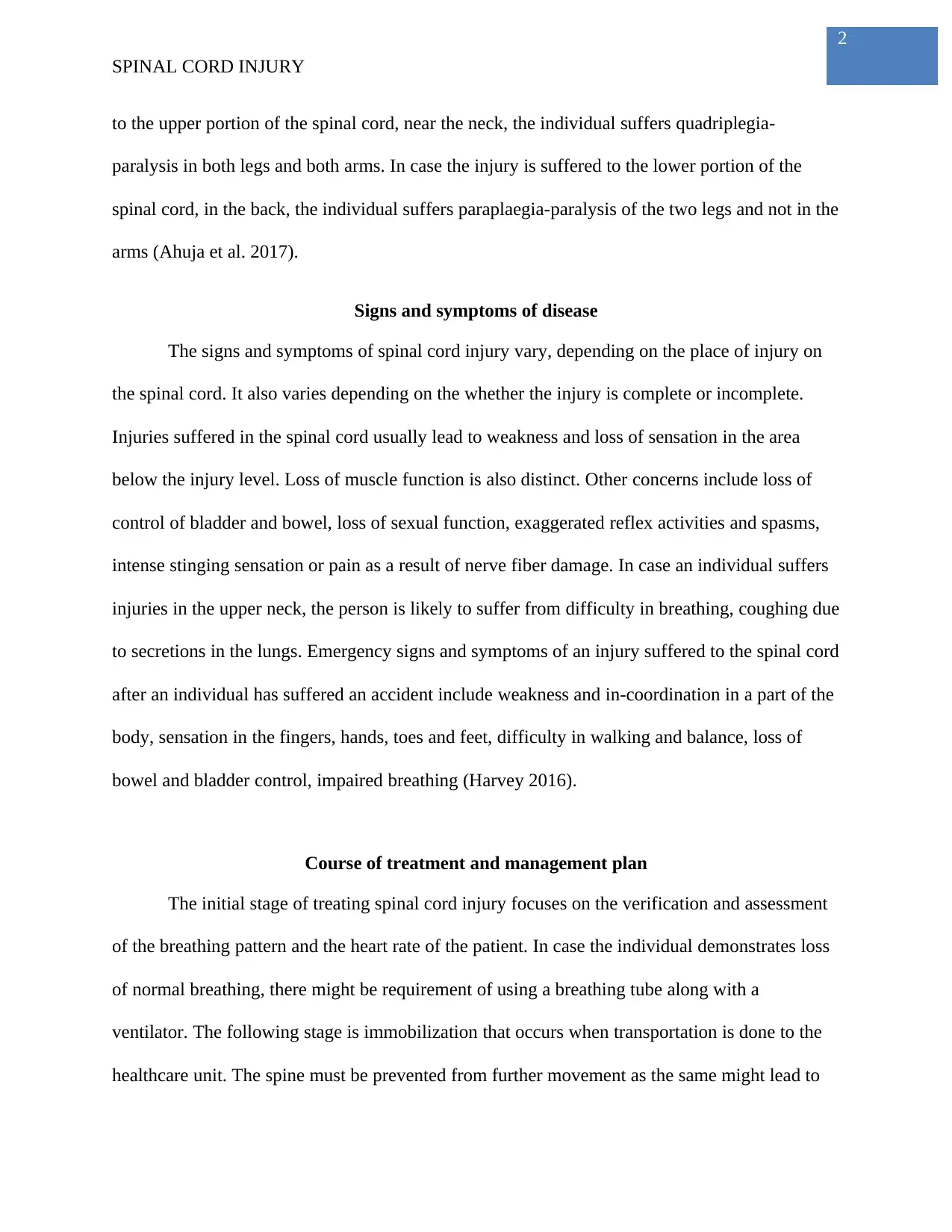
2
SPINAL CORD INJURY
to the upper portion of the spinal cord, near the neck, the individual suffers quadriplegia-
paralysis in both legs and both arms. In case the injury is suffered to the lower portion of the
spinal cord, in the back, the individual suffers paraplaegia-paralysis of the two legs and not in the
arms (Ahuja et al. 2017).
Signs and symptoms of disease
The signs and symptoms of spinal cord injury vary, depending on the place of injury on
the spinal cord. It also varies depending on the whether the injury is complete or incomplete.
Injuries suffered in the spinal cord usually lead to weakness and loss of sensation in the area
below the injury level. Loss of muscle function is also distinct. Other concerns include loss of
control of bladder and bowel, loss of sexual function, exaggerated reflex activities and spasms,
intense stinging sensation or pain as a result of nerve fiber damage. In case an individual suffers
injuries in the upper neck, the person is likely to suffer from difficulty in breathing, coughing due
to secretions in the lungs. Emergency signs and symptoms of an injury suffered to the spinal cord
after an individual has suffered an accident include weakness and in-coordination in a part of the
body, sensation in the fingers, hands, toes and feet, difficulty in walking and balance, loss of
bowel and bladder control, impaired breathing (Harvey 2016).
Course of treatment and management plan
The initial stage of treating spinal cord injury focuses on the verification and assessment
of the breathing pattern and the heart rate of the patient. In case the individual demonstrates loss
of normal breathing, there might be requirement of using a breathing tube along with a
ventilator. The following stage is immobilization that occurs when transportation is done to the
healthcare unit. The spine must be prevented from further movement as the same might lead to
SPINAL CORD INJURY
to the upper portion of the spinal cord, near the neck, the individual suffers quadriplegia-
paralysis in both legs and both arms. In case the injury is suffered to the lower portion of the
spinal cord, in the back, the individual suffers paraplaegia-paralysis of the two legs and not in the
arms (Ahuja et al. 2017).
Signs and symptoms of disease
The signs and symptoms of spinal cord injury vary, depending on the place of injury on
the spinal cord. It also varies depending on the whether the injury is complete or incomplete.
Injuries suffered in the spinal cord usually lead to weakness and loss of sensation in the area
below the injury level. Loss of muscle function is also distinct. Other concerns include loss of
control of bladder and bowel, loss of sexual function, exaggerated reflex activities and spasms,
intense stinging sensation or pain as a result of nerve fiber damage. In case an individual suffers
injuries in the upper neck, the person is likely to suffer from difficulty in breathing, coughing due
to secretions in the lungs. Emergency signs and symptoms of an injury suffered to the spinal cord
after an individual has suffered an accident include weakness and in-coordination in a part of the
body, sensation in the fingers, hands, toes and feet, difficulty in walking and balance, loss of
bowel and bladder control, impaired breathing (Harvey 2016).
Course of treatment and management plan
The initial stage of treating spinal cord injury focuses on the verification and assessment
of the breathing pattern and the heart rate of the patient. In case the individual demonstrates loss
of normal breathing, there might be requirement of using a breathing tube along with a
ventilator. The following stage is immobilization that occurs when transportation is done to the
healthcare unit. The spine must be prevented from further movement as the same might lead to
⊘ This is a preview!⊘
Do you want full access?
Subscribe today to unlock all pages.

Trusted by 1+ million students worldwide
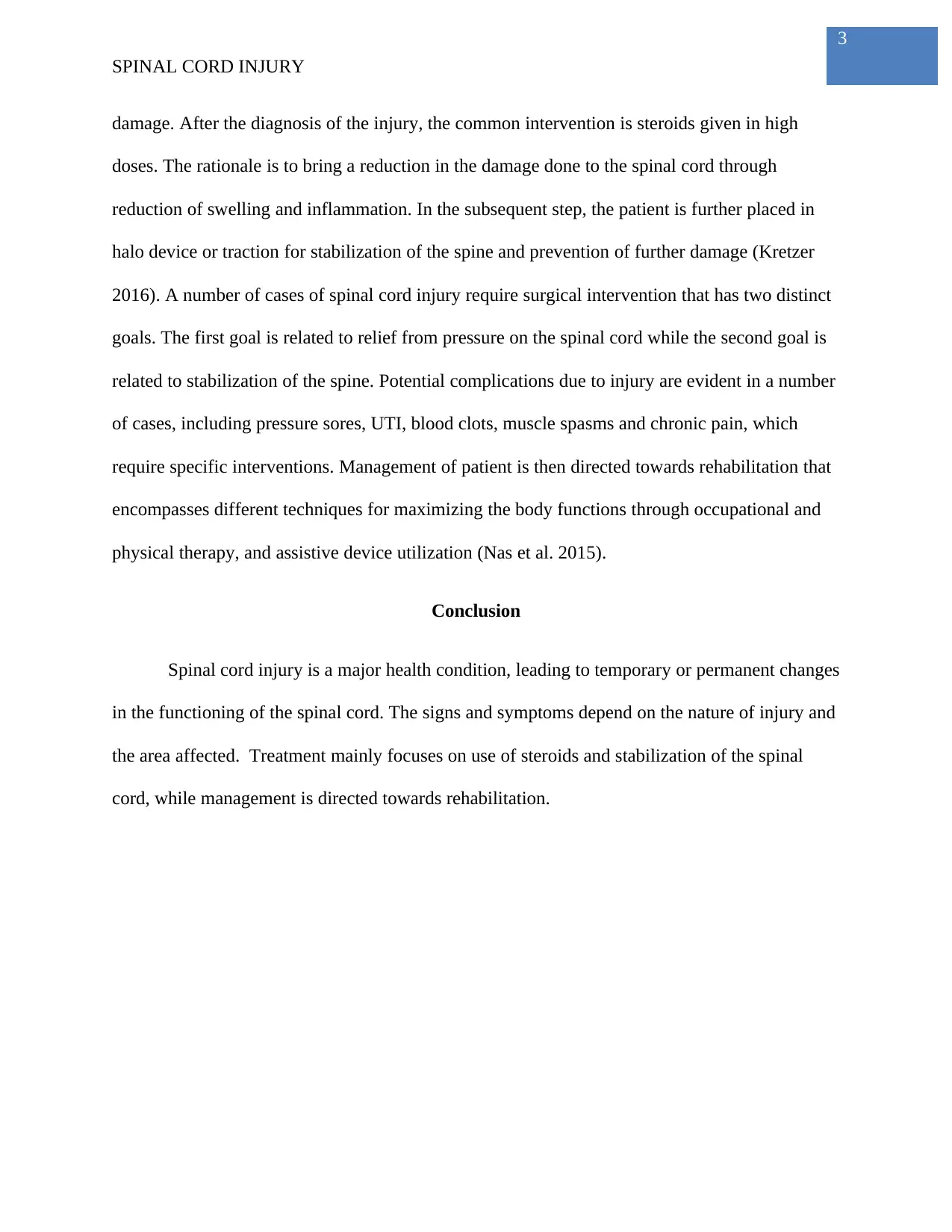
3
SPINAL CORD INJURY
damage. After the diagnosis of the injury, the common intervention is steroids given in high
doses. The rationale is to bring a reduction in the damage done to the spinal cord through
reduction of swelling and inflammation. In the subsequent step, the patient is further placed in
halo device or traction for stabilization of the spine and prevention of further damage (Kretzer
2016). A number of cases of spinal cord injury require surgical intervention that has two distinct
goals. The first goal is related to relief from pressure on the spinal cord while the second goal is
related to stabilization of the spine. Potential complications due to injury are evident in a number
of cases, including pressure sores, UTI, blood clots, muscle spasms and chronic pain, which
require specific interventions. Management of patient is then directed towards rehabilitation that
encompasses different techniques for maximizing the body functions through occupational and
physical therapy, and assistive device utilization (Nas et al. 2015).
Conclusion
Spinal cord injury is a major health condition, leading to temporary or permanent changes
in the functioning of the spinal cord. The signs and symptoms depend on the nature of injury and
the area affected. Treatment mainly focuses on use of steroids and stabilization of the spinal
cord, while management is directed towards rehabilitation.
SPINAL CORD INJURY
damage. After the diagnosis of the injury, the common intervention is steroids given in high
doses. The rationale is to bring a reduction in the damage done to the spinal cord through
reduction of swelling and inflammation. In the subsequent step, the patient is further placed in
halo device or traction for stabilization of the spine and prevention of further damage (Kretzer
2016). A number of cases of spinal cord injury require surgical intervention that has two distinct
goals. The first goal is related to relief from pressure on the spinal cord while the second goal is
related to stabilization of the spine. Potential complications due to injury are evident in a number
of cases, including pressure sores, UTI, blood clots, muscle spasms and chronic pain, which
require specific interventions. Management of patient is then directed towards rehabilitation that
encompasses different techniques for maximizing the body functions through occupational and
physical therapy, and assistive device utilization (Nas et al. 2015).
Conclusion
Spinal cord injury is a major health condition, leading to temporary or permanent changes
in the functioning of the spinal cord. The signs and symptoms depend on the nature of injury and
the area affected. Treatment mainly focuses on use of steroids and stabilization of the spinal
cord, while management is directed towards rehabilitation.
Paraphrase This Document
Need a fresh take? Get an instant paraphrase of this document with our AI Paraphraser
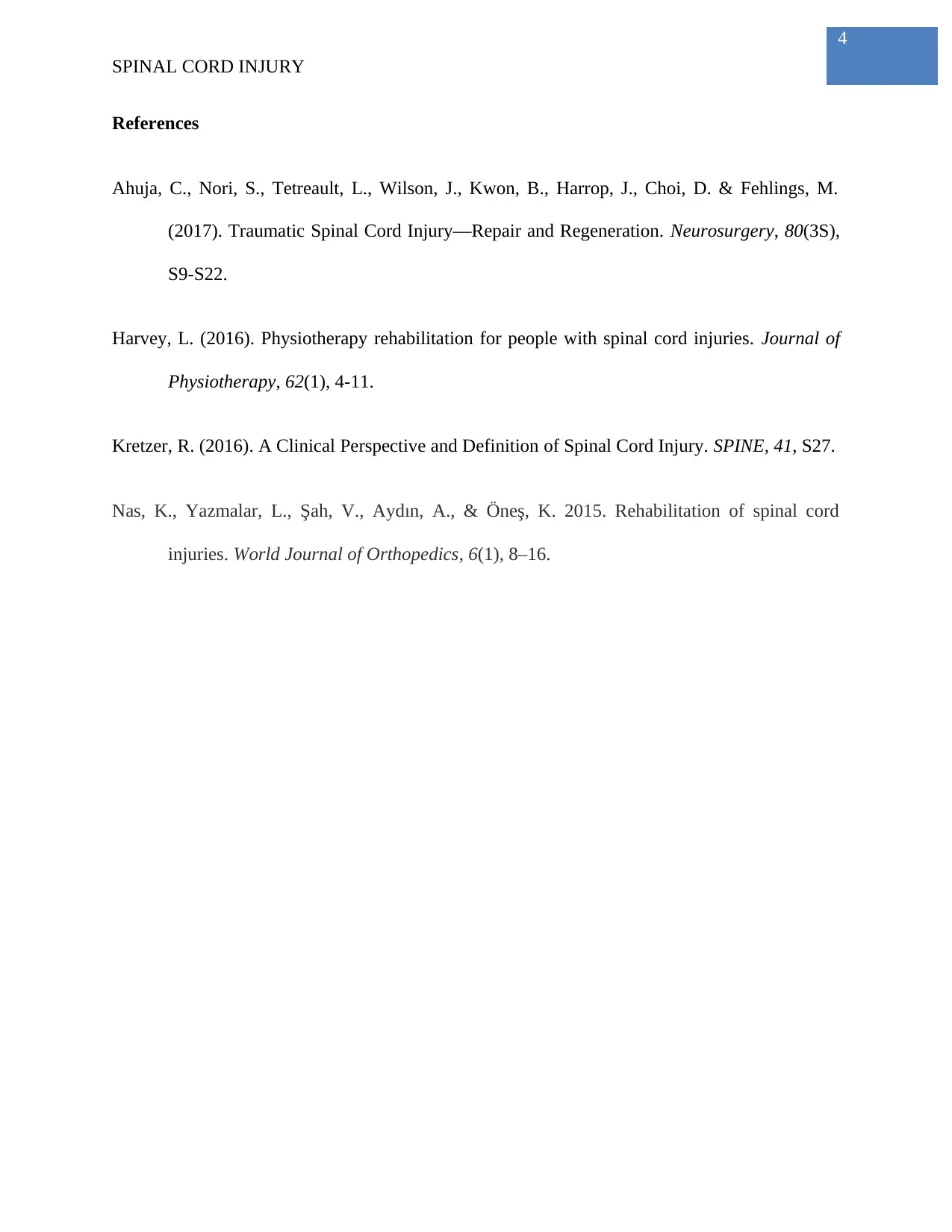
4
SPINAL CORD INJURY
References
Ahuja, C., Nori, S., Tetreault, L., Wilson, J., Kwon, B., Harrop, J., Choi, D. & Fehlings, M.
(2017). Traumatic Spinal Cord Injury—Repair and Regeneration. Neurosurgery, 80(3S),
S9-S22.
Harvey, L. (2016). Physiotherapy rehabilitation for people with spinal cord injuries. Journal of
Physiotherapy, 62(1), 4-11.
Kretzer, R. (2016). A Clinical Perspective and Definition of Spinal Cord Injury. SPINE, 41, S27.
Nas, K., Yazmalar, L., Şah, V., Aydın, A., & Öneş, K. 2015. Rehabilitation of spinal cord
injuries. World Journal of Orthopedics, 6(1), 8–16.
SPINAL CORD INJURY
References
Ahuja, C., Nori, S., Tetreault, L., Wilson, J., Kwon, B., Harrop, J., Choi, D. & Fehlings, M.
(2017). Traumatic Spinal Cord Injury—Repair and Regeneration. Neurosurgery, 80(3S),
S9-S22.
Harvey, L. (2016). Physiotherapy rehabilitation for people with spinal cord injuries. Journal of
Physiotherapy, 62(1), 4-11.
Kretzer, R. (2016). A Clinical Perspective and Definition of Spinal Cord Injury. SPINE, 41, S27.
Nas, K., Yazmalar, L., Şah, V., Aydın, A., & Öneş, K. 2015. Rehabilitation of spinal cord
injuries. World Journal of Orthopedics, 6(1), 8–16.
1 out of 5
Related Documents
Your All-in-One AI-Powered Toolkit for Academic Success.
+13062052269
info@desklib.com
Available 24*7 on WhatsApp / Email
![[object Object]](/_next/static/media/star-bottom.7253800d.svg)
Unlock your academic potential
Copyright © 2020–2025 A2Z Services. All Rights Reserved. Developed and managed by ZUCOL.





